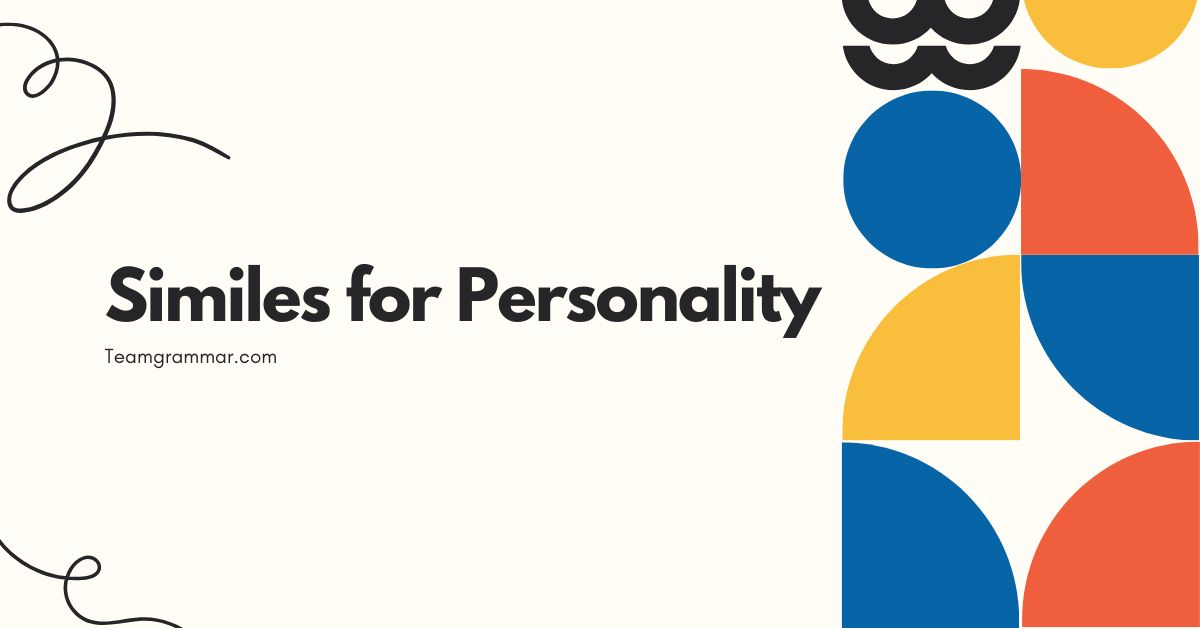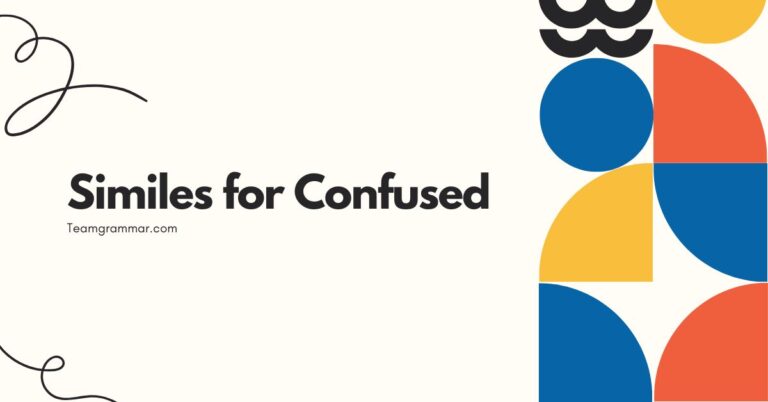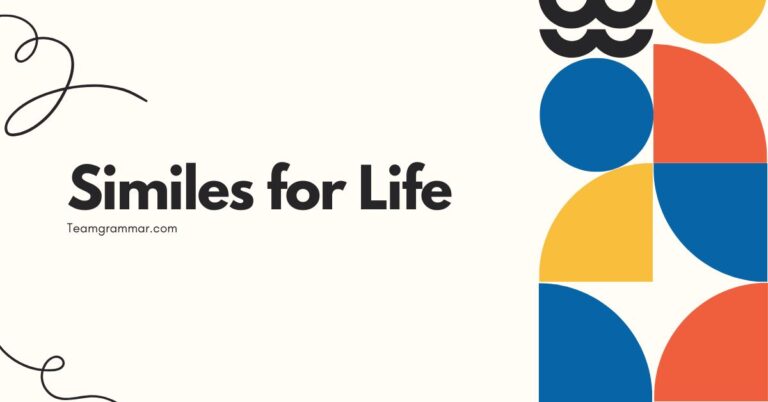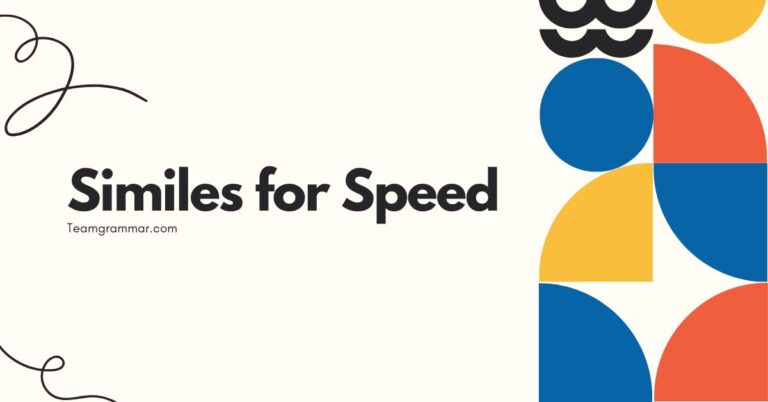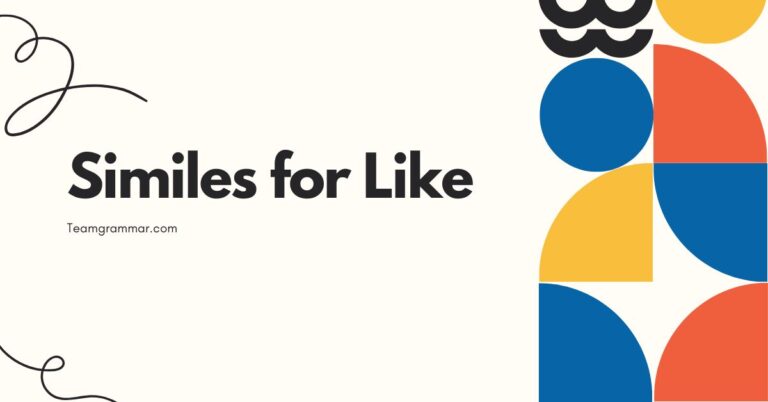37 Similes for Personality: A Comprehensive Grammar Guide
Understanding how to use similes to describe personality traits is a valuable skill in English. Similes add color and depth to your descriptions, making them more engaging and memorable.
This guide provides a comprehensive overview of similes for personality, covering their definition, structure, usage, and common mistakes. It is designed for English language learners of all levels, from beginners to advanced speakers, as well as writers looking to enhance their descriptive abilities.
Table of Contents
- Introduction
- Definition of Simile
- Structural Breakdown
- Types of Similes
- Examples of Similes for Personality
- Usage Rules
- Common Mistakes
- Practice Exercises
- Advanced Topics
- FAQ
- Conclusion
Introduction
Similes are powerful tools for enriching language and creating vivid imagery. When used to describe personality, they can transform bland statements into captivating characterizations.
This article delves into the world of similes, specifically focusing on how they can be employed to paint a more detailed and nuanced picture of a person’s character. Whether you’re writing fiction, composing a character reference, or simply trying to express yourself more effectively, mastering the art of using similes for personality will significantly improve your communication skills.
This guide is structured to provide a clear and progressive understanding of similes. We’ll begin with a foundational definition and then move on to explore the structural elements that make similes work.
Next, we’ll examine different types of similes and provide numerous examples categorized by personality trait. Finally, we’ll cover usage rules, common mistakes to avoid, and practice exercises to solidify your learning.
By the end of this article, you’ll be well-equipped to use similes confidently and creatively in your writing and speaking.
Definition of Simile
Asimileis a figure of speech that compares two unlike things using the words “like” or “as.” The purpose of a simile is to create a more vivid and relatable image in the reader’s or listener’s mind. It enhances descriptive writing by drawing parallels between something familiar and something that might be less known or understood.
Similes are frequently used in literature, poetry, and everyday conversation to add color and emphasis.
In the context of describing personality, similes help to illustrate character traits by comparing them to something else that embodies that trait. For example, saying someone is “as brave as a lion” conveys the idea of courage in a more impactful way than simply saying they are brave.
The effectiveness of a simile lies in the strength and clarity of the comparison it makes.
Classification, Function, and Contexts
Similes fall under the broader category of figurative language, which includes metaphors, personification, and hyperbole. Their primary function is to add descriptive power and emotional resonance to writing or speech.
Similes are typically used to:
- Enhance description: Making descriptions more vivid and memorable.
- Clarify meaning: Helping the audience understand a concept by comparing it to something familiar.
- Evoke emotion: Creating a specific mood or feeling in the audience.
Similes can be used in a variety of contexts, including:
- Literature: Novels, poems, and short stories often use similes to develop characters and settings.
- Everyday conversation: People use similes to express themselves more colorfully and effectively.
- Formal writing: Essays, reports, and articles can benefit from the strategic use of similes to make arguments more persuasive.
- Advertising: Similes are used to create memorable slogans and advertisements.
Structural Breakdown
The basic structure of a simile involves three key components: the subject being described, the word “like” or “as,” and the object or idea to which the subject is being compared. This structure creates a clear and direct comparison that is easy for the audience to understand.
The formula can be expressed as follows:
Subject + “like” or “as” + Object/Idea
For example:
She (subject) + is as (linking word) + calm as a still lake (object/idea).
Elements of a Simile
Let’s break down the elements of a simile with an example:
“He is as stubborn as a mule.”
- Subject: “He” – The person being described.
- Linking Word: “as” – The word that establishes the comparison.
- Object of Comparison: “a mule” – The object used to illustrate the quality of stubbornness.
The effectiveness of a simile depends on the appropriateness and familiarity of the object of comparison. A good simile creates a clear and understandable connection between the subject and the object, making the description more vivid and impactful.
Patterns and Rules
While the structure of a simile is relatively simple, there are a few rules and patterns to keep in mind:
- Use “like” for nouns and pronouns: “He runs like the wind.”
- Use “as” with adjectives or adverbs: “She is as quick as a fox.”
- Ensure the comparison is logical and relatable: Avoid comparing things that have no clear connection.
The key to creating effective similes is to choose objects of comparison that are commonly associated with the trait you are trying to describe. For example, using “lion” to describe courage or “fox” to describe cunning are both well-established and easily understood comparisons.
Types of Similes
Similes can be categorized based on the type of comparison they make and the effect they create. Understanding these categories can help you choose the most appropriate simile for your writing or speaking.
Direct Similes
Direct similes make a clear and explicit comparison using “like” or “as.” They are straightforward and easy to understand. These are the most common types of similes.
Example: “He is as quiet as a mouse.”
Implied Similes
Implied similes suggest a comparison without explicitly stating it. This type of simile requires the reader to infer the comparison, making it more subtle and nuanced.
Example: “She tiptoed through the room, a shadow in the night.” (Implies she is like a shadow)
Humorous Similes
Humorous similes use comparisons that are funny or absurd to create a comedic effect. These similes are often used in informal settings to lighten the mood.
Example: “He was as useful as a screen door on a submarine.”
Ironic Similes
Ironic similes use comparisons that are the opposite of what is expected to create irony or sarcasm. These similes can be used to express disapproval or mockery.
Example: “He’s about as sharp as a marble.”
Examples of Similes for Personality
The following tables provide a comprehensive list of similes used to describe various personality traits. These examples are categorized to make it easier to find the right simile for your needs.
Similes for Positive Traits
This table showcases similes that can be used to describe admirable and positive personality characteristics.
| Trait | Simile |
|---|---|
| Brave | As brave as a lion |
| Kind | As kind as an angel |
| Intelligent | As smart as a whip |
| Loyal | As loyal as a dog |
| Calm | As calm as a still lake |
| Patient | As patient as a saint |
| Generous | As generous as they come |
| Cheerful | As cheerful as a lark |
| Optimistic | As optimistic as Pollyanna |
| Honest | As honest as the day is long |
| Wise | As wise as an owl |
| Creative | As creative as da Vinci |
| Hardworking | As hardworking as an ant |
| Helpful | As helpful as a Swiss Army knife |
| Friendly | As friendly as a golden retriever |
| Polite | As polite as a butler |
| Reliable | As reliable as sunrise |
| Sincere | As sincere as a newborn baby |
| Thoughtful | As thoughtful as a monk |
| Tolerant | As tolerant as Gandhi |
| Resourceful | As resourceful as MacGyver |
| Passionate | As passionate as a tango dancer |
| Empathetic | As empathetic as a therapist |
| Disciplined | As disciplined as a soldier |
| Gracious | As gracious as a queen |
Similes for Negative Traits
This table provides similes to describe less desirable or negative personality characteristics.
| Trait | Simile |
|---|---|
| Stubborn | As stubborn as a mule |
| Lazy | As lazy as a sloth |
| Arrogant | As arrogant as a peacock |
| Greedy | As greedy as a pig |
| Rude | As rude as a boor |
| Aggressive | As aggressive as a bull |
| Jealous | As jealous as a hawk |
| Pessimistic | As pessimistic as Eeyore |
| Dishonest | As dishonest as a politician |
| Mean | As mean as a snake |
| Clumsy | As clumsy as a newborn giraffe |
| Forgetful | As forgetful as a sieve |
| Impatient | As impatient as a toddler |
| Insecure | As insecure as a first-time performer |
| Naive | As naive as a lamb |
| Secretive | As secretive as a spy |
| Reckless | As reckless as a stunt driver |
| Picky | As picky as a toddler with vegetables |
| Bossy | As bossy as a sergeant |
| Vain | As vain as Narcissus |
| Sarcastic | As sarcastic as Chandler Bing |
| Gullible | As gullible as a child |
| Pessimistic | As pessimistic as a rainy day |
| Apathetic | As apathetic as a stone |
| Manipulative | As manipulative as a puppeteer |
Similes for Neutral Traits
This table includes similes for personality traits that are neither inherently positive nor negative, but simply descriptive.
| Trait | Simile |
|---|---|
| Quiet | As quiet as a mouse |
| Shy | As shy as a violet |
| Energetic | As energetic as a hummingbird |
| Serious | As serious as a judge |
| Curious | As curious as a cat |
| Busy | As busy as a bee |
| Determined | As determined as a bulldog |
| Reserved | As reserved as a librarian |
| Elegant | As elegant as a swan |
| Formal | As formal as a state dinner |
| Observant | As observant as a hawk |
| Practical | As practical as a Swiss army knife |
| Logical | As logical as Spock |
| Artistic | As artistic as Van Gogh |
| Independent | As independent as a lone wolf |
| Adaptable | As adaptable as a chameleon |
| Analytical | As analytical as Sherlock Holmes |
| Witty | As witty as Oscar Wilde |
| Organized | As organized as a filing cabinet |
| Talkative | As talkative as a parrot |
| Dramatic | As dramatic as a soap opera |
| Eccentric | As eccentric as Salvador Dali |
| Meticulous | As meticulous as a surgeon |
| Resilient | As resilient as bamboo |
| Modest | As modest as a shrinking violet |
Similes for Emotional Traits
This table includes similes focused on describing a person’s emotional state or tendencies.
| Trait | Simile |
|---|---|
| Happy | As happy as a clam |
| Sad | As sad as a willow tree |
| Angry | As angry as a hornet |
| Anxious | As anxious as a cat in a room full of rocking chairs |
| Fearful | As fearful as a lamb among wolves |
| Content | As content as a cat purring |
| Excited | As excited as a kid in a candy store |
| Lonely | As lonely as a cloud |
| Guilty | As guilty as a child with chocolate on their face |
| Hopeful | As hopeful as a sunrise |
| Depressed | As depressed as a rainy Monday |
| Jealous | As jealous as a green-eyed monster |
| Optimistic | As optimistic as a perpetual spring |
| Pessimistic | As pessimistic as a broken record |
| Relaxed | As relaxed as a Sunday morning |
| Stressed | As stressed as a tightrope walker |
| Surprised | As surprised as a deer in headlights |
| Worried | As worried as a mother hen |
| Calm | As calm as a Buddhist monk |
| Enthusiastic | As enthusiastic as a cheerleader |
Usage Rules
Using similes effectively requires understanding and adhering to certain rules. These rules ensure that your similes are clear, impactful, and grammatically correct.
Grammatical Correctness
Ensure that your simile is grammatically sound. The comparison should be logical and the sentence structure should be correct.
Use “like” to compare nouns and pronouns, and “as” with adjectives and adverbs.
Correct: He runs like the wind.
Correct: She is as quick as a fox.
Incorrect: He runs as the wind.
Incorrect: She is like quick as a fox.
Clarity and Relevance
The comparison you make in a simile should be clear and relevant. The object or idea you are comparing the subject to should be easily understood and have a logical connection to the trait you are describing.
Clear: He is as stubborn as a mule.
Unclear: He is as stubborn as a doorknob.
Avoid Cliches
Cliches are overused similes that have lost their impact. While they may be easy to use, they often sound unoriginal and uninspired.
Try to come up with fresh and creative comparisons instead.
Cliche: As busy as a bee.
Original: As busy as a one-armed paper hanger.
Consistency
Maintain consistency in your writing style and tone. If you are writing in a formal style, avoid using overly casual or humorous similes.
If you are writing in an informal style, feel free to use more creative and playful comparisons.
Contextual Appropriateness
Consider the context in which you are using the simile. A simile that is appropriate in one situation may not be appropriate in another.
For example, a humorous simile may be suitable for a casual conversation but not for a formal presentation.
Common Mistakes
Even experienced writers sometimes make mistakes when using similes. Being aware of these common errors can help you avoid them in your own writing.
Mixing Up “Like” and “As”
One of the most common mistakes is using “like” and “as” interchangeably. Remember that “like” is typically used to compare nouns and pronouns, while “as” is used with adjectives and adverbs.
Incorrect: She is like intelligent as her sister.
Correct: She is as intelligent as her sister.
Incorrect: He runs as a cheetah.
Correct: He runs like a cheetah.
Illogical Comparisons
Making comparisons that don’t make sense can confuse the reader and weaken your writing. Ensure that the object of comparison has a clear and logical connection to the subject.
Illogical: He is as happy as a rock.
Logical: He is as happy as a clam.
Overusing Similes
While similes can enhance your writing, using too many can make it sound forced and unnatural. Use similes sparingly and strategically to maximize their impact.
Overuse: He was as brave as a lion, as strong as an ox, and as quick as a fox.
Better: He was as brave as a lion.
Using Inappropriate Similes
Using similes that are not appropriate for the context or audience can be jarring and ineffective. Consider the tone and purpose of your writing when choosing similes.
Inappropriate (in a formal setting): He was as cool as a cucumber.
Appropriate (in a formal setting): He was as calm as a still lake.
Practice Exercises
Test your understanding of similes with these practice exercises. Each exercise includes a series of questions and their corresponding answers.
Exercise 1: Identifying Similes
Identify the similes in the following sentences.
| Question | Answer |
|---|---|
| 1. She sings like an angel. | like an angel |
| 2. He is as tall as a tree. | as tall as a tree |
| 3. The snow was a white blanket. | (No simile – this is a metaphor) |
| 4. The children ran like wild horses. | like wild horses |
| 5. The news hit him like a ton of bricks. | like a ton of bricks |
| 6. Her smile was as bright as the sun. | as bright as the sun |
| 7. The city was a jungle. | (No simile – this is a metaphor) |
| 8. He eats like a pig. | like a pig |
| 9. The cake was as light as a feather. | as light as a feather |
| 10. Time is a thief. | (No simile – this is a metaphor) |
Exercise 2: Completing Similes
Complete the following similes with an appropriate ending.
| Question | Answer |
|---|---|
| 1. He is as brave as a _____. | lion |
| 2. She is as quiet as a _____. | mouse |
| 3. They are as busy as _____. | bees |
| 4. The food was as cold as _____. | ice |
| 5. The water is as clear as _____. | glass |
| 6. He is as stubborn as a _____. | mule |
| 7. She is as graceful as a _____. | swan |
| 8. They are as different as _____ and _____. | night and day |
| 9. The joke was as old as _____. | the hills |
| 10. The car is as fast as a _____. | rocket |
Exercise 3: Writing Similes
Write your own similes to describe the following personality traits.
| Trait | Example Simile |
|---|---|
| Kind | As kind as an angel |
| Lazy | As lazy as a sloth |
| Energetic | As energetic as a hummingbird |
| Arrogant | As arrogant as a peacock |
| Shy | As shy as a violet |
| Happy | As happy as a clam |
| Sad | As sad as a willow tree |
| Angry | As angry as a hornet |
| Calm | As calm as a summer breeze |
| Generous | As generous as Santa Claus |
Advanced Topics
For advanced learners, exploring more complex aspects of similes can further enhance their understanding and usage.
Extended Similes
An extended simile is a simile that is developed over several lines or sentences. This allows for a more detailed and nuanced comparison.
Example: “Her laughter was like a melody, a sweet and enchanting tune that filled the room and brought joy to everyone who heard it. It was as if the air itself was dancing to the rhythm of her happiness.”
Nested Similes
Nested similes involve using one simile within another. This creates a layered effect and adds depth to the description.
Example: “He was as strong as an ox, a veritable mountain of a man, as immovable as a rock in a raging river.”
Subverting Expectations
Breaking established patterns or playing with common associations can create unique and memorable similes. This involves using unexpected comparisons to challenge the reader’s expectations.
Example: “He was as brave as a kitten facing a lion.” (Ironic use – kittens are not usually brave when facing lions)
FAQ
Here are some frequently asked questions about similes:
- What is the difference between a simile and a metaphor?
A simile compares two things using “like” or “as,” while a metaphor states that one thing is another. A simile is a comparison, whereas a metaphor is an assertion of identity. For example, “He is like a lion” (simile) vs. “He is a lion” (metaphor).
- Can a simile be a cliche?
Yes, a simile can become a cliche if it is overused and loses its impact. It’s best to avoid common similes and try to create original comparisons.
- How can I make my similes more creative?
To make your similes more creative, try to think outside the box and come up with unexpected comparisons. Consider using sensory details and vivid imagery to enhance the impact of your similes.
- Is it okay to use similes in formal writing?
Yes, similes can be used in formal writing, but they should be used sparingly and appropriately. Choose similes that are clear, relevant, and consistent with the tone of the writing.
- What are some common mistakes to avoid when using similes?
Some common mistakes to avoid include mixing up “like” and “as,” making illogical comparisons, overusing similes, and using inappropriate similes.
- How can I improve my understanding of similes?
To improve your understanding of similes, practice identifying and writing them. Read widely and pay attention to how authors use similes in their writing. You can also use online resources and grammar guides to learn more about similes.
- Are similes only used in writing?
No, similes are used in both writing and speaking. They are a common feature of everyday conversation and can be used to add color and emphasis to your speech.
- Can I use similes to describe abstract concepts?
Yes, similes can be used to describe abstract concepts by comparing them to something more concrete and familiar. This can help to make complex ideas more understandable and relatable.
- How do I know if a simile is effective?
An effective simile creates a clear and vivid image in the reader’s or listener’s mind. It should be easily understood and have a logical connection to the subject being described. If the simile confuses or distracts the audience, it is not effective.
- What is the purpose of using similes in descriptive writing?
The purpose of using similes in descriptive writing is to enhance the imagery and make the writing more engaging. They help to paint a more detailed and nuanced picture of the subject being described, making it easier for the audience to visualize and understand.
- How can I use similes to make my characters more memorable?
Use similes that reflect the character’s personality, background, or unique traits. A well-chosen simile can reveal a lot about a character in a short amount of time, making them more memorable and relatable to the reader.
- Are there any cultural considerations when using similes?
Yes, some similes may be culturally specific and not easily understood by people from different backgrounds. Be mindful of your audience and choose comparisons that are likely to be familiar and relevant to them.
Conclusion
Similes are a powerful tool for adding depth and color to your descriptions, especially when characterizing personalities. By understanding their structure, types, and usage rules, you can effectively use similes to create vivid and memorable imagery.
Remember to avoid cliches, ensure grammatical correctness, and consider the context in which you are using the simile. With practice, you can master the art of using similes to enhance your writing and speaking skills.
To further improve your skills, continue to practice writing similes and pay attention to how they are used in literature and everyday conversation. Experiment with different types of comparisons and don’t be afraid to be creative.
The more you practice, the more confident and skilled you will become in using similes to express yourself effectively. Ultimately, mastering similes will enrich your ability to communicate ideas and paint compelling portraits of personality.

